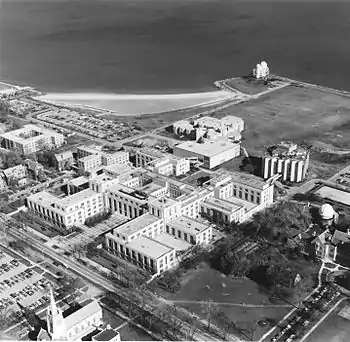Lindheimer Astrophysical Research Center
Lindheimer Astrophysical Research Center was an astronomical observatory used for teaching and research, located on the Evanston, Illinois campus of Northwestern University. The structure was built in 1966 and was demolished in 1995.[1]
 Lindheimer Center in 1974 | |||||
| Alternative names | Lindheimer Observatory | ||||
|---|---|---|---|---|---|
| Named after | Benjamin F. Lindheimer | ||||
| Organization | Northwestern University | ||||
| Location | Evanston, Illinois, U.S. | ||||
| Coordinates | 42°3′34.25″N 87°40′13.53″W | ||||
| Altitude | 600 ft. | ||||
| Established | 1966 | ||||
| Closed | 1995 | ||||
| Telescopes | |||||
| |||||
 Location of Lindheimer Astrophysical Research Center | |||||
| | |||||
History

The Center was constructed in 1966 on the Lake Michigan shore in the northeast corner of the recently completed Northwestern University Lakefill and its twin domes and distinctive crisscrossed supporting braces instantly made it a campus landmark. That year, the Chicago Chapter of the American Institute of Architects designated the structure as outstanding in its class.[2]
The observatory building which housed the Center originally cost approximately one million dollars. It was funded by a gift from the estate of prominent Chicago businessman and sporting executive Benjamin F. Lindheimer along with a grant from the National Science Foundation.[3] The telescopes were funded mainly by grants from the A. Montgomery Ward Foundation, the Hans D. Isenberg Foundation, and the National Science Foundation.[3]
The facility's domes contained two large telescopes manufactured by premium instrument maker Boller and Chivens. Beneath the smaller dome was a 16-inch Cassegrain reflector, intended mainly for student use. Beneath the larger dome was a 40-inch Cassegrain equipped with a rapid-scanning optical spectrometer, intended especially for astronomical research.[1][4]
By the 1990s, the Center's usefulness had diminished, in part because of the poor "seeing" conditions of the Chicago area, where light pollution and atmospheric turbulence are persistent problems, and in part because of the need for expensive remediation of the structure due to the presence of asbestos insulation and lead-based paint.[1] Accordingly, the University decided, despite expressions of public support for the well-known landmark, that the cost-effective course of action was to tear down the Center.[2] The telescopes were donated to Lowell Observatory in Flagstaff, Arizona[1] and the demolition proceeded in mid-September, 1995.[5]
As a testimonial to the integrity of the original design, the explosive detonations used for the first demolition attempt resulted in the whole structure remaining intact and simply listing to one side, still held firmly together by its network of external supporting braces. Subsequently, the braces were cut away using large industrial cutting torches.[5]
Today the site is green space adjoined by a parking lot.[6]
- Gallery
 Lindheimer Center (top) in 1977
Lindheimer Center (top) in 1977 Looking north along the Lakefill seawall
Looking north along the Lakefill seawall At night in 1974
At night in 1974
References
- "History of the Lindheimer Astrophysical Center". Northwestern University. 4 August 2014. Archived from the original on 3 March 2016. Retrieved 23 March 2016.
- James Hill (20 July 1995). "Observatory's Twilight: Northwestern Ready To Raze Towering Shoreline Landmark". Chicago Tribune. Retrieved 23 March 2016.
- "Lindheimer Observatory: Dedication". Robert Lentz. 28 Oct 1995. Retrieved 23 March 2016.
- "Photos of the two Lindheimer telescopes". Drew Milsom. 18 Dec 1997. Retrieved 26 March 2016.
- "Lindheimer Demolition (with photos of "Leaning Tower of NU")". Philip R. "Pib" Burns. 21 March 2000. Retrieved 23 March 2016.
- "Satellite view of northeast corner of Northwestern Univ. Lakefill".